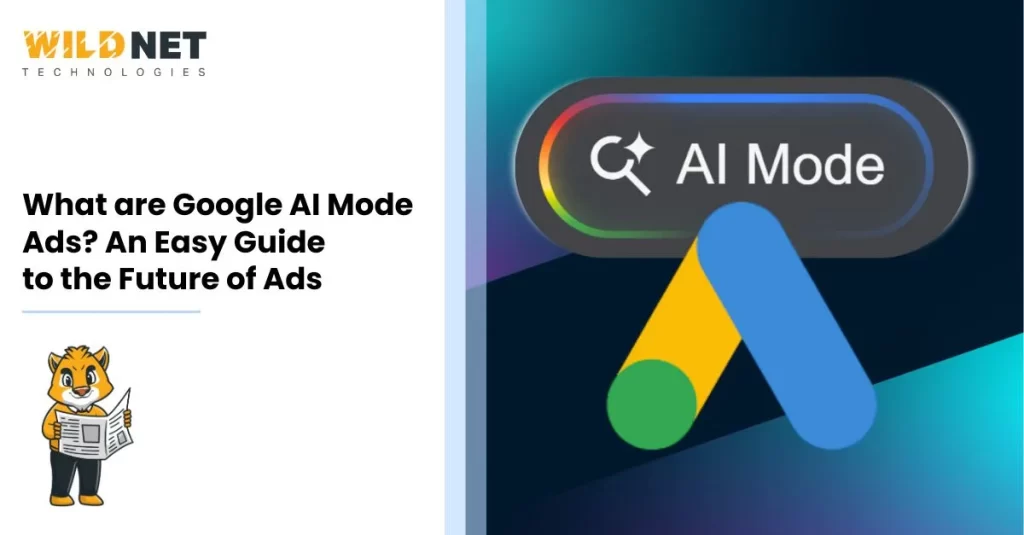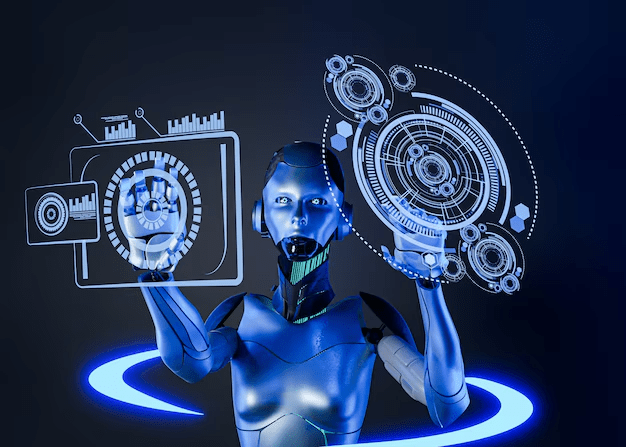Summary
Google AI Mode Ads integrate directly into AI-powered search conversations, delivering contextually relevant and highly personalized ads.
Unlike traditional search ads, they appear within AI-generated answers, enhancing engagement and trust.
Plus, due to AI Overviews and AI Mode, users hardly scroll down to look at Google search ads.
This conversational & intent-driven ad format gives brands new opportunities to connect with users earlier in their decision journey.
Key Takeaways
- Contextual & Conversational – Ads appear within AI-generated responses, blending naturally with user interactions.
- Intent-Driven Targeting – Focuses on understanding user intent beyond keywords for better ad relevance.
- Personalized Experiences – Real-time customization based on user data and conversation context.
- Future-Ready Strategy – Early adopters gain a competitive edge as AI-driven search ads grow.
Table of Contents
► What are Google AI Mode Ads?
► Why Are Google AI Mode Ads Important in 2025?
► What are the Best Practices for Google AI Mode Ads?
Google AI Mode Ads represent a groundbreaking shift in the digital advertising landscape, redefining how brands connect with consumers in 2025.
As Google integrates artificial intelligence (AI) deeper into its search engine, Google AI mode ads emerge as the future of online advertising—conversational, contextual, and highly personalized.
If you were still at the “Google is bringing ads to AI mode” level, Wildnet is here to take you deeper.
Google Ads AI Mode overviews 2025
- Google AI Mode was introduced after experiments in March 2025.
- It was launched in July 2025 in India.
- Google AI Mode Ads first appear in May 2025 in the USA.
- India got its confirmation about AI Mode Ads at Google Marketing Live 2025.
- AI is making Google Ads easier, which used to be a hassle because of managing 8 or more variables.
–
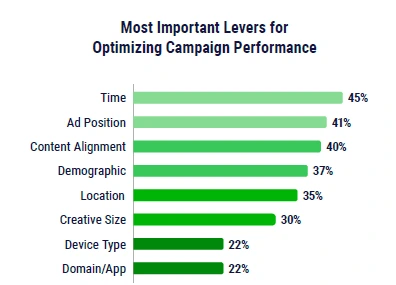
8 Reasons Why Google Ads Are a Challenge
What is Google AI Mode?
Google AI Mode is an advanced and conversational search experience powered by Gemini AI.
It delivers personalized, multimodal, and context-aware answers.
By integrating web links and follow-ups, it is making Google search more interactive, accurate, and intuitive than traditional results.
In short, users get an AI chatbot instead of the boring Google search.
What are Google AI Mode Ads?
Google AI Mode Ads are a new type of advertising integrated directly within Google’s AI-powered search experience called AI Mode.
Unlike traditional search ads that appear alongside a list of links, these ads are embedded within AI-generated answers and conversational responses, making them feel natural & less intrusive.
In AI Mode, Google’s AI understands the entire context of user queries—often complex & exploratory questions—and serves ads that seamlessly match the conversation flow.
This shift means ads are no longer just triggered by keywords but by user intent and the broader dialogue happening between the user & Google’s AI assistant.
You can only use them in India and the USA.
Why Are Google AI Mode Ads Important in 2025?
With over 100 million users already engaging with AI Mode, Google Ads AI overviews are positioned as one of the most impactful innovations in search advertising this decade.
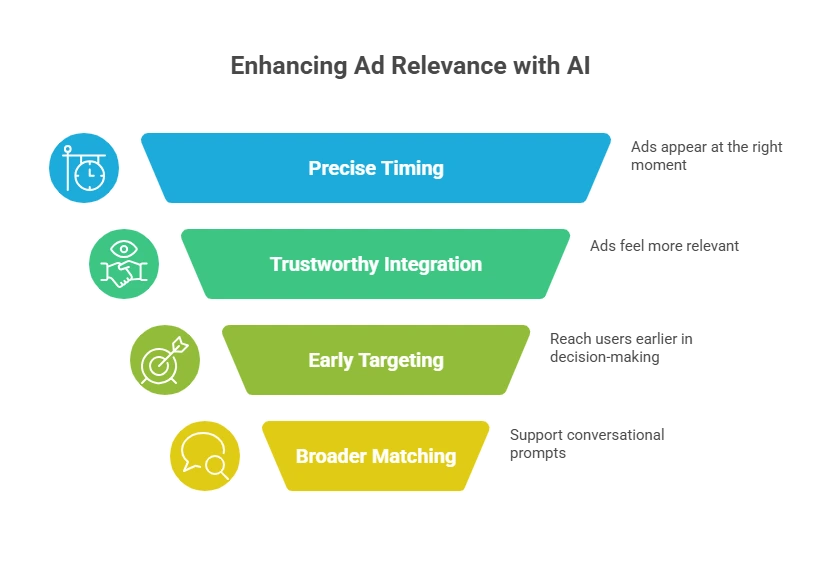
4 reasons why you should choose Google AI Mode Ads
Here’s why:
- They allow brands to appear at the precise moment users ask complex & intent-rich questions.
- Ads integrated into AI responses feel more trustworthy and relevant, boosting user engagement.
- Advertisers can target users earlier in their decision-making journey, unlocking commercial intent in queries that traditional search ads couldn’t access before.
- This new format supports broader match targeting and conversational prompts, fostering better ad relevance & performance.
As Google expands AI Mode ads throughout 2025, early adopters stand to gain significant competitive advantages by embracing this shift.
Google AI Mode Ads vs Google Ads
Let’s understand the key difference to help you choose better.
| Factors | Google AI Mode Ads | Google Ads |
| Understanding | Based on user intent & conversation | Based on keywords |
| Placement | Within AI Overviews and AI Mode | Above or between Organic search results (below AI Overview) |
| Personalization | Real-time personalization | Some level of personalization |
| User Engagement | Best because of the chatting experience | Basic |
| Pro Tip | Use it for Gen Z | Use it for Boomers |
Google AI Mode Ads vs Google Ads
With this comparison, your next PPC strategy can witness an improved ROI (return on investment).
How to Use Google AI Mode Ads?
Before we tell you how they work, let’s discuss how they appear.
AI Mode ads integration 2025 appear as “Sponsored” content within or below AI-generated responses.
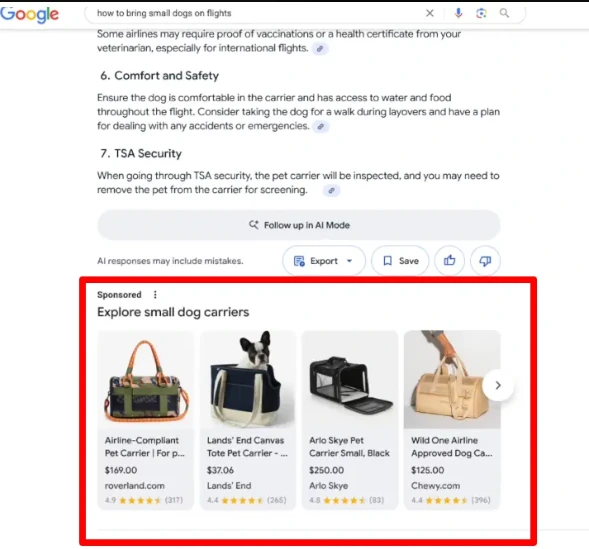
A screenshot of a Google AI Mode ad
Google AI Mode Ad: Steps
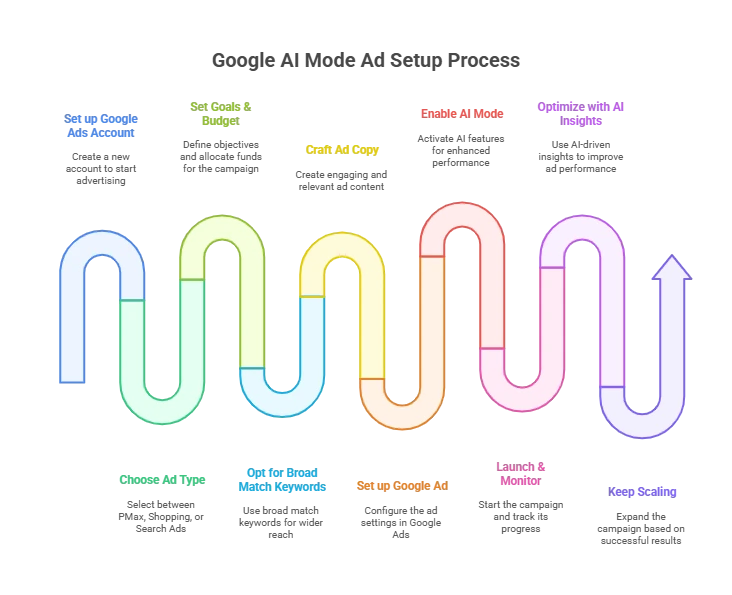
10 steps to Google AI Mode Ads
Here are the ten steps to glory in 2025.
1. Set up a Google Ads Account
2. Choose between PMax, Shopping and Search Ads (broad match)
3. Set Goals & Budget
4. Opt for Broad Match keywords & Intent-driven targeting
5. Craft a Conversational & Relevant Ad copy
6. Set up the Google Ad
7. Enable AI Mode Ad (campaign settings)
8. Launch & Monitor
9. Optimize as per AI-powered Insights
10. Keep Scaling
It’s as easy as 1, 2, 3, if you know what to do.
What are the Best Practices for Google AI Mode Ads?
Knowing these best practices will help your next Google Ads campaign become the most beneficial one ever in 2025.
- PMax is best for omnichannel automated optimization.
- KPIs (key performance indicators) for AI Mode ads need to be analyzed separately.
Paid ad success awaits; will you choose it? Try the Google AI mode ads monetization.
The Future of Paid Ads
Google AI Mode Ads are bringing in a new era of conversational advertising where AI assists users while subtly and effectively showcasing sponsored content.
This approach addresses longstanding challenges with ad intrusiveness and relevance by embedding ads in natural dialogue.
As AI technology evolves, we can expect AI Mode ads to become more sophisticated by integrating voice search, image recognition, and multimodal interactions.
Personalized offers, dynamic creatives, and deeper user insights will push the boundaries of targeted advertising, making AI Mode the cornerstone of digital marketing strategies in the years to come.
Conclusion
By embracing Google AI mode ads, brands unlock unparalleled opportunities to engage users in meaningful & intent-driven ways.
This will help in serving both the advertisers and consumers better than ever.
The future of ads is here, and it’s powered by Google’s AI Mode.
If your brand or client is ready to make the move…
Wildnet Technologies is here with its best AI marketing services to make brands appear at the top across all channels.
We offer next-level omnichannel marketing.
Like to read more,
- Power Pack in Google Ads: Performance Max, AI Max for Search Campaigns & More
- Is AI Max the Future of Google Paid Search 2025 Onwards?
- Wildnet’s Glossary
- Digital Yum (our weekly update about the latest in the marketing world from the thought leadership’s desk).
Connect with us now at “info@wildnettechnologies.com” and try the AI Mode Ads now.
FAQs
FAQ 1: What are the benefits of Google AI Mode ads?
Ans: Here is what your brand or client can hope to gain.
- Better Conversions
- Increased ROI
- Boosted Brand Authority
- Future Readiness
FAQ 2: Is Google bringing ads to AI Mode?
Ans: Yes, ads in Google AI Mode have been launched in the USA and India.
While the UK currently has AI Mode but not the ads.
FAQ 3: What is AI in Google Ads?
Ans: There are various types of AI tools used in Google Ads.
A few of them are as follows:
- AI in Performance Max (PMax)
- AI Max
- Google AI Mode
They are powered by Gemini, which is Google’s AI.
FAQ 4: How do I enable AI Mode in Google?
Ans: If you are from the USA, India or the UK, AI Mode Google Ads will be automatically enabled.
If you still don’t see it, you can check if your Chrome is of the latest version and then enable AI mode.
FAQ 5: Who should use Google AI mode ads?
Ans: Every brand and marketer should experiment with it while focusing on the Millennial and Gen Z audiences.
It will prove beneficial in the zero-click era.
